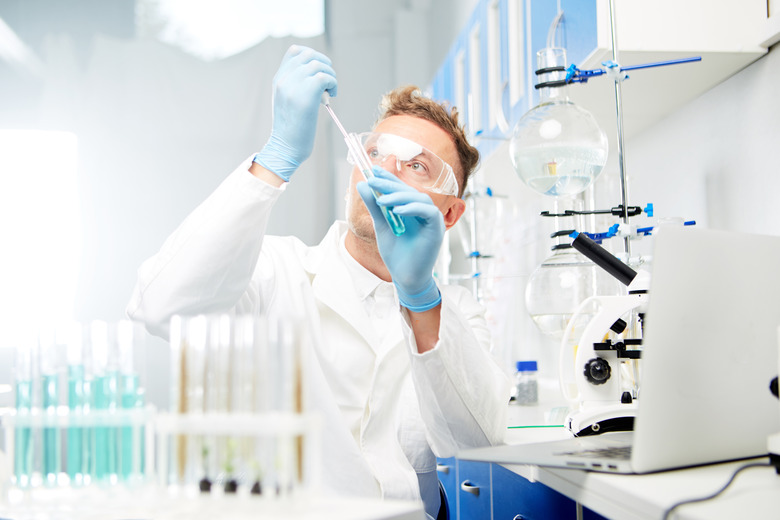What Does ADP In Biology Do?
ADP stands for adenosine diphosphate, and it's not only one of the most important molecules in the body, it's also one of the most numerous. ADP is an ingredient for DNA, it's essential for muscle contraction and it even helps initiate healing when a blood vessel is breached. Even with all those roles, however, there's one even more important: storing and releasing the energy within an organism.
Structure
Structure
ADP is built with a few component molecules. It starts with adenine, which is one of the purine bases that contain information within DNA. When the adenine is joined with a sugar molecule, it becomes a nucleoside called adenosine. Then adenosine can accept a phosphate group, or two, or three. A phosphate group is built from one atom of phosphorus attached to three oxygen atoms. An adenosine with one phosphate group attached is called adenosine monophosphate, or AMP — and it is also now called a nucleotide. Add another phosphate group and you get adenosine diphosphate, or ADP. Throw on one more phosphate group and you get adenosine triphosphate, or ATP. AMP, along with three other monophosphate nucleotides, are the components of DNA.
Energy in ADP and ATP
Energy in ADP and ATP
Without ADP and ATP, there would be almost no life on Earth. Plants and animals use ADP and ATP to store and release energy. ATP has more energy than ADP, which means it takes energy to make ATP from ADP, but it also means that energy is released when ATP is converted to ADP. Living organisms constantly cycle between ATP and ADP. Starting with ADP, plants put energy from sunlight into the formation of ATP, while animals take energy from glucose to build ATP from ADP. Living organisms cycle through their entire store of ATP and ADP about once a minute. If you couldn't recycle your ADP into ATP, you would need to eat your body weight in ATP every day just to stay alive.
Using Energy
Using Energy
Just about every cell in your body uses ATP to supply energy. The action in muscle cells provides an illustration of how ATP supplies energy to other molecules. Your muscles contract when one set of tiny molecules grip onto other molecules that are kind of like long cables in your muscle cells. The gripping molecules grab, pull, release and grab along. That takes energy. When the pulling motion is finished, a gripping molecule has no ATP or ADP. A molecule of ATP fits onto the gripping molecule and immediately loses one phosphate group. The conversion from ATP to ADP transfers energy to the gripping molecule, which moves back to its grabbing position. It grabs onto the cable molecule and then relaxes back into its pulling position, where it gives up the ADP and gets ready for another ATP and the start of another gripping cycle.
Other Uses for ADP
Other Uses for ADP
As you have seen, your body has a lot of ADP around, and it's a handy molecule for storing and releasing energy, so the body has put it to many other uses. For example, ADP and ATP provide energy for receiving and sending ions that carry signals between neurons. And when you get cut, the platelets that close up your blood vessels release ADP to attract and bind with other platelets, gathering them up to block the breach and stop the loss of blood. ADP has many other biological functions, from repairing cell damage to controlling which genes get "turned on" to make their proteins.
Cite This Article
MLA
Gaughan, Richard. "What Does ADP In Biology Do?" sciencing.com, https://www.sciencing.com/what-does-adp-in-biology-do-12072977/. 25 June 2018.
APA
Gaughan, Richard. (2018, June 25). What Does ADP In Biology Do?. sciencing.com. Retrieved from https://www.sciencing.com/what-does-adp-in-biology-do-12072977/
Chicago
Gaughan, Richard. What Does ADP In Biology Do? last modified August 30, 2022. https://www.sciencing.com/what-does-adp-in-biology-do-12072977/
